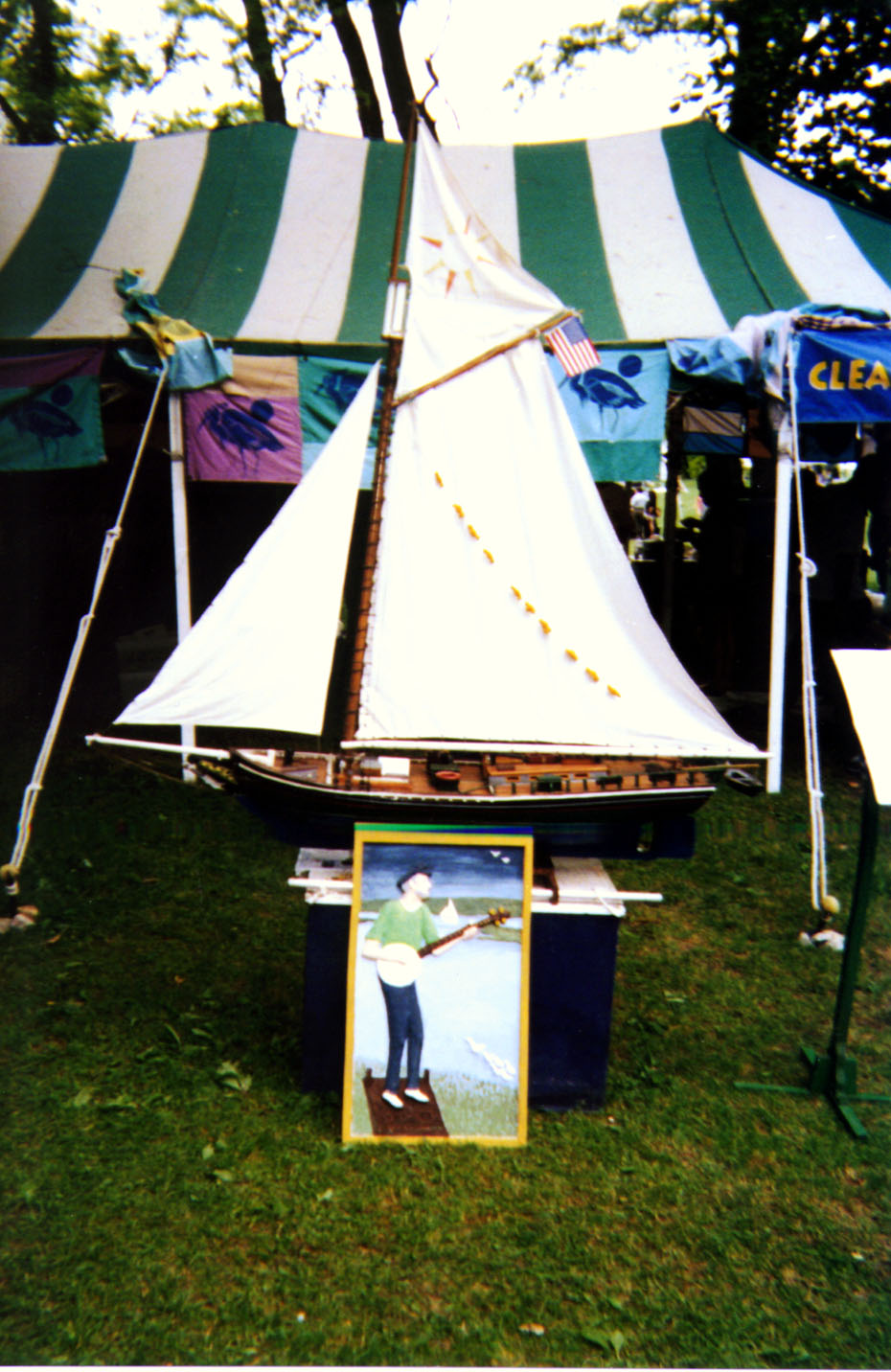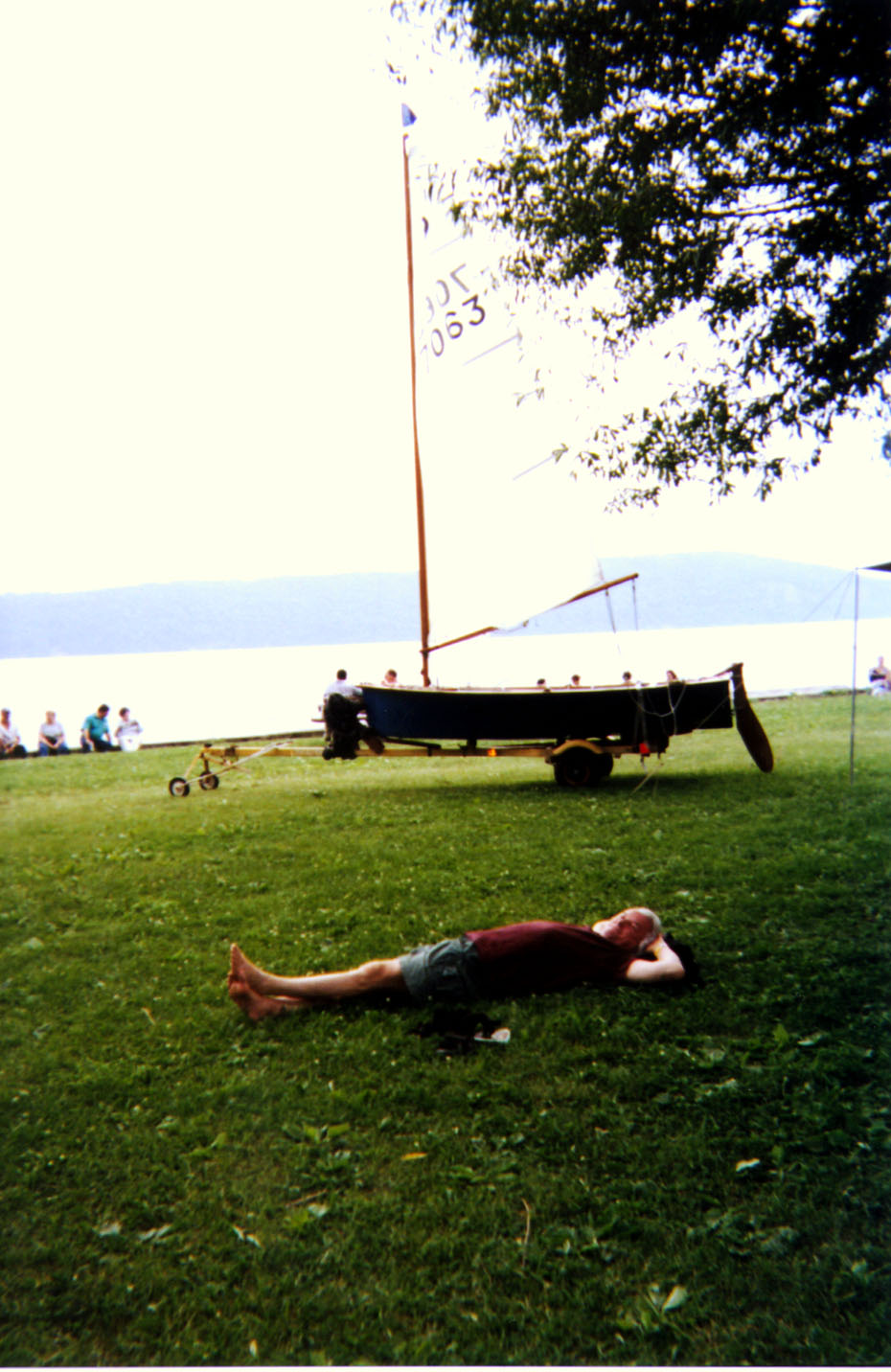
Series Reviews
The Annual Clearwater Festival, 6/16-17 (Croton-on-Hudson, NY)
The International River Network's Second Annual "Politics and Poetry of Rivers"
(Featuring Gary Snyder, San Francisco)
The Seventh Annual West Chester University (Pa.)
Poetry Conference on Form & Narrative
~ . ~ . ~
Clearwater: The Great Hudson River Revival Music & Environmental Festival: June 16 and 17
In July, 1976, hundreds of tall ships from around the world sailed into New York harbor and up the Hudson River, the ultimate floats in a parade to celebrate the U.S. bicentennial. Even New Yorkers were awed, and took pictures from their apartment windows (see, e.g. http://www.yourdon.com/photos/1976tallships.html). The ships return now and then for special occasions.
However, for all their antique majesty and foreign color, the vessel that moves us is our own, the Hudson River Sloop known as "Clearwater," which plies the river the rest of the year without fanfare as a tribute to its romantic history [see Article, this issue. Ed.], but also as a quiet reminder of our constant responsibility as the stewards of its ecological future. A traditional 19th century replica built with the initiative of folk icon and activist Pete Seeger, its mainsail's delicate white elegance is emblem for the annual festival at Croton Point (45 minutes north of Manhattan, just south of Westpoint Military Academy) and flagship for several smaller vessels and festivals operated by sloop clubs from here to Albany harbor.

For a half an hour on Saturday afternoon, the (solar-powered) rock music, sea chanteys, storytellers and jugglers paused for a ceremonial blessing of the river.

Booth and tent exhibits of water celery and tanks of indigenous fish alternated with river photography and crafts displayed in teepees. The serious business of Hudson River activists was clearly and often ingeniously stated.

A sole vegetarian vendor of briny greens and the honest-to-goodness, though fattening, ingredients of environmental darlings Ben & Jerry's Vermont ice cream were the only relief among the garish pizza-taco-falafel eye-, nose-, and tongue-torment of tent-vended food. Spring water was provided free by Leisure Time.
The weekend was an enormous cooperative undertaking among NFPs, the Westchester County parks board, and the weather, which entertained and educated thousands. Masterful organizational skills paired volunteers with every relevant detail from free shuttle bus service from public transportation to the recovery of lost car keys and kids. The festival maintains a website at http://www.clearwater.org, with sailing schedules and booking information for the Sloop. For those interested in knowing more, a Google search (keyword: hudson river) provides a wealth of links to other projects.
-- MH
~ . ~
Series Review
The International River Network's Second Annual "Politics and Poetry of Rivers"
by Julie Tsai
On May 17, a brisk Thursday San Francisco evening at Aquatic Park's Maritime Museum, environmentalists and philanthropists gathered to hear Pulitzer Prize-winning poet Gary Snyder read from his book, Mountains and Rivers Without End (Washington, D.C., Counterpoint. 1996). Surrounded by the steady lapping of waves against the wharf and the night-lit East Bay across the water visible through the window-ringed dining room, benefit-goers enjoyed Snyder's spirited and contemplative poems of nature and man's relation to it against the peaceful backdrop of the Bay at night.
The occasion was both literary event and fundraiser to benefit the Berkeley-based International Rivers Network, a not-for-profit organization that advocates for protection of natural water resources and indigenous rights around the world. Guests bid on silent auction items like whitewater rafting trips, artwork by local artisans, and weekend getaways over chardonnay before dinner at the low-key and elegant affair. The $250-a-plate diners included a diverse mix of age groups, from young NFP staffers to polished professionals in evening costume and distinguished grandfatherly types. The Maritime Museum, perched between Golden Gate Park and the west end of Fisherman's Wharf, is a small historic landmark built to resemble a 1930's oceanliner.
After dinner, the program opened with remarks by IRN chairman Paul Strasburg and executive director Juliette Majot. Next, Robert Hass, the former U.S. Poet Laureate and an IRN board member, praised the IRN, saying "how happy I am to see a handful of people in Berkeley working over dinner in a Brazilian pizzeria, bringing the World Bank to its knees."
Hass then introduced Snyder, the program headliner as "one of the most important artists of the twentieth century. It is as hard to capture the greatness of his mind as it is to capture the majesty and suppleness of a river."
Snyder, a slender man with bright eyes and an easy carriage, began, "I thought I wouldn't know anybody, but it turns out it's all friends! Which shows there is a culture in North California." Then he launched into an anecdote of how "of course, [the work of the IRN] is of the utmost importance, but I would not be here but for (board member) Walter Sedgwick, who once pulled me out of a river on a rafting trip."
Snyder was a witty speaker and a good reader of his own work. He talked of his adventures in the outdoors and his experiences abroad, including an archaeological dig in the Czech Republic. He read from from Mountains and from Coming into the Watershed (Pantheon, 1994), works characterized both by a sense of personal humility and the majesty of nature, as well as a sensuous physicality. He also laced his remarks with good-humored deprecation of himself and his native country's politics.
Snyder said, that forty years ago when he resided in Japan and began what would become Mountains, he had vowed to "fight the negative influence of my own civilization, but (40 years later) Hiroshima is doing fine now, and Mount St. Helen's is half gone." He read "We Wash Our Bowls in This Water":
Su Tung-p'o sat out one whole night by a creek on the slopes of
Mt. Lu. Next morning he showed this poem to his teacher:
The stream with its sounds is a long broad tongue
The looming mountain is a side-awake body
Throughout the night song after song
How can I speak at dawn.
Old Master Chang-tsung approved him. Two centuries later
Dogen said,
"If you, who are valley streams and looming
mountains,
Can't throw some light on the nature of ridges and rivers,
who can?"
Both Snyder and the IRN stressed the interconnection of the sanctity of the environment and human rights, especially those of indigenous people.
Snyder, a peer of beat poets and beatniks Allen Ginsberg and Jack Kerouac, is an accomplished anthropologist and scholar of Chinese, Japanese, and Zen Buddhism. These influences, as well as a robust respect for indigenous cultures and their approach towards nature, infuse much of Snyder's poetry and imagery. He has published sixteen works of poetry and prose, including Turtle Island which won the Pulitzer Prize for poetry in 1975. After the long poem cycle Mountains and Rivers Without End was published in 1996, Snyder was honored with the Bollingen Poetry Prize and the Robert Kirsch Lifetime Achievement Award from The Los Angeles Times. In the book notes, Snyder said the title for the work was inspired by an East Asian handscroll painting of the same name. He describes the elements of such paintings, "the energies of mist, white water, rock formations, air swirls" as "a chaotic universe where everything is in place."
The IRN is an international advocate for responsible development of water resources and the preservation of indigenous ways of life. Suzanne Wong, Southeast Asia Campaign assistant indicated that the organization promotes reparation campaigns to spur corporations and dam-builders to take responsibility for the effects of their interventions and works with local water commissioners to pressure institutions like the World Bank for better resource planning. The IRN has a staff of twenty in its Berkeley office, but operates campaigns all over the world, including South America and Southeast Asia. The annual "River of Words" children's poetry competition, "River of Words," fosters ecological awareness and poetry among youngsters.
The organization maintains an extensive website at www.irn.org.
(Julie Tsai lives and works in San Francisco. This is her first contribution to the magazine. She writes occasionally for other online journals such as somalit.com and maximag.com.)
~ . ~ . ~
Series Review:
The Seventh Annual West Chester University (Pa.)
Poetry Conference on Form & Narrative
by Rob Wright
Over four days, from June 6 to 9, poets, teachers, and experts in the art read, lectured, and performed. Workshops were conducted on writing, publishing, and performing. The contribution of poet Richard Wilbur was recognized and celebrated.
The conference was refreshingly professional: I never had the sense that poetry was a secondary activity for anyone there. No apologies were made for craft or intention. The question often asked, "Is this really what you want to do?" was rendered absurd. All of the seminars and workshops I attended addressed issues that poets practicing the craft, or teaching it, might encounter. Heather Draper made an excellent case for structure in poetry, even for poets who make a virtue out of having none.
In his workshop on writing poetry for music, Dana Gioia emphasized that devices which may not work on the page--repetition, hard end rhyme, hitting key words--are essential in writing for music. The most surprising thing he said was that the real challenge for the librettist was not in finding composers to work with (they are out there) but in working with a composer.
There were parallels to the experience of working in traditional forms since structure creates a sort of freedom. Auden (arguably, the greatest librettist in the twentieth century) said that writing free verse was possible, but difficult, because the poet, like Robinson Crusoe, had to create everything himself, and at the end it all looked a little shabby.
As Gioia spoke about the evolution of poetic forms in music, from the masque to the nineteenth century opera, I realized that this was information that I was prepared to hear, and that writing had prepared me to hear it. Personally, I am interested in writing poetry for music and this information, offered by a writer working in the craft has been difficult, if not impossible, to find.
There was a reading by R. S. Gwynn in which he made Browning's Childe Roland an academic whose dark tower was a chair in Poetry. You don't have to be on the inside to get the joke. I am not a teacher or academic, but I do know what hard work poetry is and what a debt I owe to teachers--and to laymen--who have bothered to listen.
For me, one of the highpoints at the conference was a reading by the poet Kim Addonzio about giving birth. She focused on the moment when the baby was not part of her anymore and there was a shift: The baby was going to have a life of its own; whatever had been protecting the poet and the baby had made a sudden departure and handed it over to the poet.
How well the craft of poetry could be put into practice was the demonstrated in a performance of Nosferatu, a concert version of an opera with libretto by Dana Gioia and music by Alva Henderson, based on the silent film by F.W. Murnau.
The story is a familiar one--itself an adaptation from Bram Stoker's Dracula. A traveler goes to the Carpathian Mountains to negotiate a real estate transaction. There, he meets a monster in human form, a dead nobleman who thrives on the blood of the living. In Murnau's script, as in Gioia's libretto, the action is simplified. The quartet of lovers from the book is reduced to two, a husband and wife, and the action stays in Central Europe, moving from the Balkans to the Baltic coast. The book's gypsy henchmen are absent (likewise in the film, the count drives his own coach), as are the Count's sexy brides, and a host of walk-on characters. In the opera, this distills the action to no more than six characters, excluding the chorus, which is used quite effectively.
Odd though the device may be of adapting what is in essence a purely visual medium of the silent film to what is in essence the medium of the willing suspension of disbelief, it works quite well.
In silent films the settings and dialogue are presented as title cards which the actors then act out, and this is what happened in the songs. The themes of prophetic dreams, seduction, and madness are presented by the characters and then developed in poetry and music.
Gioia and Henderson have not only mastered their respective crafts, but obviously enjoy their collaboration. This is not the poetry of the confession and the complaint, but rather, the poetry of song in the tradition of Wyatt, Ben Johnson, and W.H. Auden. The mad song, a device I have a particular fondness for, was perfect. Except for the modern language, it might have been written by Purcell. The joy of listening to words, to the tick-tock under all the meaning, the way I loved language as a child, was there.
My first encounter with Nosferatu was in a class in film school. The film was old, faded, and scratched, and at first I had difficulty seeing it as anything but an artifact. As I watched, what happened to the main characters happened to me: I was drawn in, fascinated and horrified. I can think of no scene quite as unsettling as the Count Orlock passing over the hatch of the death ship. Something similar happened when I saw the concert version of the opera.
At first I was comparing the songs to the film action or listening to the way the poetry had been adapted, but when the count appeared, I was drawn in. The seduction of Eric, the husband, by the count, was genuinely disturbing. What Gioia has done is to bring back the sexuality of Stoker's original story, but without losing film's horror of the foreigner, the 'Other.' In Stoker, the count's exotic origin is picturesque; in Murnau (as a Central European), it is seminal.
In his workshop, Gioia pointed out that almost all of the operas in the standard repertoire were written by a handful of teams, and that this success is dependent on the collaborators' consent that neither the music nor the poetry should be sacrificed for one or the other. The pleasure these two artists take in each other's work is evident in performance. Gioia also told us that there were composers eager to work with poets, that there is a great need which living poets can fill. I find that idea exciting, even as I recognize that there may be plenty of composers eager to work with Gioia, and he is extending the compliment to the rest of us.
(Rob Wright is a frequent contributor to the magazine. He lives in Philadelphia.)